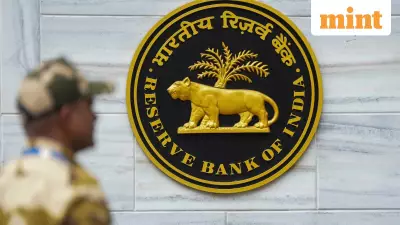
The rapid rise of artificial intelligence represents more than just technological progress—it constitutes a fundamental macroeconomic shift that is forcing central banks worldwide to reconsider their traditional approaches. For the Reserve Bank of India, this transformation presents both unprecedented opportunities and complex challenges in its mission to maintain price stability while fostering economic growth.
The Dual Nature of AI's Economic Impact
According to Tao Zhang, chief representative for Asia and the Pacific at the Bank for International Settlements, AI is revolutionizing not only private financial systems but also the operational frameworks of central banking institutions. Speaking at the Global Fintech Fest, Zhang emphasized that monetary authorities must now carefully balance the benefits and risks of artificial intelligence while preserving their core responsibility of ensuring monetary and financial stability.
The diffusion of AI technology affects economies through both supply and demand channels. Machine learning capabilities can unlock significant productivity improvements across multiple sectors. In India, where the services economy generates substantial data and manufacturing undergoes digital transformation, AI has the potential to create positive supply shocks that boost output while easing inflationary pressures.
The BIS Annual Economic Report 2024 confirms that widespread productivity gains from AI could strengthen long-term economic growth and simplify inflation management. In theory, enhanced productivity expands economic capacity, reduces cost-push inflation pressures, and helps the RBI achieve its inflation targets without implementing excessively tight monetary policies.
Labor Market Challenges and Disinflation Risks
However, this potential productivity dividend comes with significant countervailing risks. AI systems may eliminate certain job categories faster than they create new employment opportunities, particularly affecting middle-skill workers. Given India's substantial digital and income divides, generative AI benefits might concentrate among skilled urban professionals while lower-skilled workers face displacement.
Such developments could weaken household consumption patterns and exacerbate economic inequality, potentially undermining aggregate demand even as productivity improvements boost supply. The RBI must therefore function as a real-time observer of these labor market transitions, carefully distinguishing between positive disinflation resulting from efficiency gains and negative disinflation caused by weak demand and job losses.
This analytical challenge requires access to faster and more detailed economic data than traditional quarterly and annual surveys can provide. The central bank needs more responsive indicators to accurately assess the evolving economic landscape shaped by AI adoption.
AI's Transformative Role in Central Banking Operations
Artificial intelligence is already revolutionizing how central banks conduct economic analysis and policy formulation. AI-powered nowcasting techniques generate real-time estimates of growth and inflation by processing high-frequency economic signals. Institutions like the European Central Bank already employ natural language processing and large language models to analyze news coverage, social media sentiment, and business narratives.
For the Reserve Bank of India, the potential applications are particularly significant. India generates enormous volumes of real-time digital data through UPI transactions, e-way bills, satellite imagery, and social media activity. Despite this data abundance, policy decisions still rely heavily on lagging economic indicators.
With AI-based nowcasting systems, the RBI could detect supply chain disruptions, measure consumer sentiment, and estimate regional economic activity almost instantaneously. For instance, AI algorithms could analyze regional fuel sales or transportation patterns to infer local inflation trends, or assess public sentiment from vernacular media to gauge household inflation expectations. Such capabilities could substantially reduce the policy response lag that often hampers effective economic management.
Nevertheless, central banking experts caution that AI should serve as decision support rather than replacement for human judgment. Machine learning models can sometimes produce inaccurate results, misinterpret context, or fail to adapt when economic conditions change unexpectedly. Therefore, maintaining human oversight and implementing explainable AI safeguards remains essential for responsible deployment.
Financial Supervision in an AI-Driven Ecosystem
The implications of artificial intelligence become even more pronounced in financial supervision and regulation. India's thriving fintech ecosystem, built on UPI infrastructure and populated by numerous digital lenders, offers both financial inclusion benefits and potential instability risks.
In this context, AI-driven supervisory technology becomes critically important. These systems can identify anomalous patterns, monitor inter-bank exposures, and analyze alternative credit indicators such as utility payment histories or mobile data usage patterns. Such capabilities enable financial institutions to extend credit facilities to individuals without formal credit histories.
However, these advanced tools carry their own risks, particularly concerning algorithmic bias. AI systems can unintentionally perpetuate discrimination embedded in their training data. Another significant concern involves third-party dependency, as much of the global AI infrastructure remains concentrated among a limited number of technology providers. This concentration creates potential single points of failure that could disrupt financial systems.
The RBI must therefore ensure vendor diversification, conduct rigorous stress testing of digital infrastructure, and enforce comprehensive business continuity plans for financial entities operating in AI-enhanced environments.
Monetary Policy Transmission in the Algorithmic Age
Artificial intelligence also alters how monetary policy transmits through the economy. Algorithmic pricing systems enable large retailers to adjust prices instantly in response to economic shocks, potentially accelerating inflation transmission. Similarly, AI-based portfolio management and non-bank lending platforms can quicken market reactions to interest rate changes, shortening the lag between policy implementation and economic effect.
These developments could complicate the RBI's calibration of liquidity measures and interest rates. More concerning, if multiple financial institutions employ similar AI trading or credit-scoring models, their synchronized responses could amplify market volatility and create herding behavior during periods of economic stress. Consequently, the RBI must integrate AI-driven feedback mechanisms into its policy models and strengthen systemic risk monitoring capabilities.
Building Collaborative AI Governance Frameworks
The substantial costs and complexity associated with developing sophisticated AI models and data governance structures exceed the capacity of any single institution. The RBI must therefore foster a domestic "community of practice" among Indian regulators to share best practices, establish data standards, and develop shared AI tools.
Simultaneously, the central bank should engage with international organizations like the BIS and participate in G20 discussions to help shape global standards for AI governance, cyber resilience, and data sharing that account for the specific needs of emerging economies.
As artificial intelligence continues to redefine economic landscapes worldwide, the RBI's success will depend on how quickly it transitions from being a technology adopter to becoming a sophisticated regulator and architectural leader in an AI-driven future. The institution must navigate this transformation while preserving its fundamental mandate of maintaining economic stability in one of the world's most dynamic developing economies.
These insights represent the author's personal views. The author serves as professor of economics and executive director of the Centre for Family Business & Entrepreneurship at Bhavan's SPJIMR.





